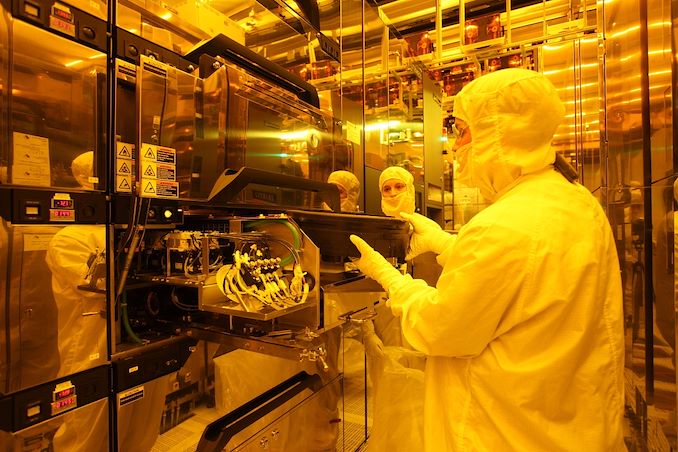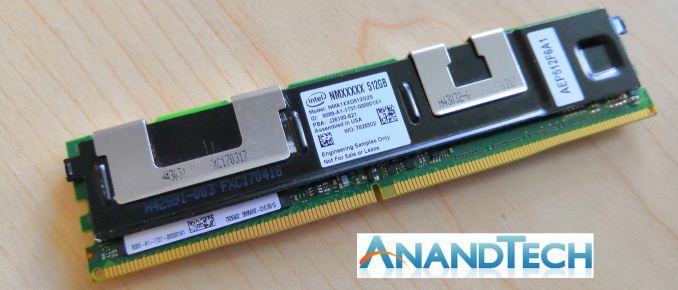Intel & Micron Sign New 3D XPoint Wafer Supply Agreement
by Anton Shilov on March 16, 2020 4:15 PM EST
Intel and Micron have inked a new 3D XPoint memory wafer supply agreement. Analysts believe that Intel will now have to pay Micron more than it did previously as it is now the only maker of 3D XPoint. The new pact also shows that Intel wants to continue making products based on 3D XPoint, but details about the products remain to be seen.
Having ended its NAND and 3D XPoint partnerships with Micron, Intel sold its former partner its stake in their mutually owned fab in Lehi, Utah. Since the company yet has to move production of 3D XPoint memory used for its Optane-branded products to its Fab 68 in Dalian, China, the chipmaker had to sign a supply agreement with Micron, under which the latter would sell the memory to its former ally at pre-agreed prices for one year after it gains ownership of the fab.
Micron gained ownership back in October, which is when the agreement came into effect. As it turns out, the two companies terminated the deal on March 9 and signed a new one ‘with changes to pricing and forecast terms’. The companies did not reveal additional details, but Micron said that the deal was ‘not material to Micron and does not change Micron’s previously-communicated outlook’.
Meanwhile, market analysts believe that Intel loses rather massive amounts of money on its 3D XPoint products despite their premium pricing.
Jim Handy, an analyst with Objective Analysis, told Blocks & Files the following:
“Intel is losing money in its NVM Solutions Group (NSG) because 3D XPoint is proving very unprofitable to produce. By my estimate Intel lost about $2 billion on 3D XPoint in each of 2017 and 2018, and $1.5 billion in 2019.”
Perhaps, indirectly, not very favorable costs of 3D XPoint are confirmed by Micron’s reluctance to build products on their base. So far, Micron has announced only one SSD series featuring 3D XPoint memory, the X100. The new deal indicates that Intel has plans to proceed with its 3D XPoint-based Optane family of products, which play an important role to its datacenter business. Unfortunately, it is unclear from the announcement how Intel plans to develop its 3D XPoint lineup going forward.
The official statement from Intel and Micron reads as follows:
On March 9, 2020, Micron Technology, Inc. (“Micron”) and Intel Corporation (“Intel”) agreed to terminate, effective March 6, 2020, the Product Supply Agreement, dated April 6, 2012, among Micron, Intel, and Micron Semiconductor Asia Pte. Ltd. (the “PSA”). The PSA set forth the terms under which Micron agreed to supply 3D XPoint wafers to Intel at prices determined under a defined formula and in accordance with a negotiated forecast. Contemporaneous with the PSA’s termination, Micron and Intel entered into a new 3D XPoint wafer supply agreement with changes to pricing and forecast terms. The new agreement is not material to Micron and does not change Micron’s previously-communicated outlook that underutilization charges associated with Micron’s Lehi, Utah fab will average approximately $150 million on a quarterly basis in fiscal year 2020.
Related Reading
- Intel Memory Plans: No New NAND Capacity, Wants to Move 3D XPoint Production to China
- Micron to Pay Intel $1.3B to $1.5B for IM Flash Stake
- Intel And Micron To Discontinue Flash Memory Partnership
- Micron Finally Announces A 3D XPoint Product: Micron X100 NVMe SSD
Sources: Micron, Blocks & Files











20 Comments
View All Comments
PeachNCream - Tuesday, March 17, 2020 - link
Is Star Citizen that one game Chris Roberts was trying to make a few years ago? It has been a really long time since I've heard anything about it. Shouldn't it be out of development at this point and available as a retail product?Joe.Blobers - Tuesday, March 17, 2020 - link
Trying? +500 devs, 5 studios, Alpha 3.8.2 and 3.9 delivered by end of March. That for Star Citizen (MMO) with quarterly patch. The solo part ala Wing Commander is Squadron 42 and do have a Beta planned to start by end of this year.Of course those not able to handle true Alpha should not consider it as polished and finished, it is not but yet a lot of fun with features not in any others triple-A.
Talking about SSD specifically, it is close to mandatory to use an SSD (currently 50GB of data). Not an Optane, any SSD will do it.
edzieba - Tuesday, March 17, 2020 - link
Ah, it's like the early days of SSDs all over again. First there were a niche datacentre/HPC thing at exorbitant cost, then you had a handful released for the consumer market at exorbitant cost (remember the dodgy JMicron drives, and the X25-E at @$12/gb for a mere 30GB drive?). Now, SSDs are ubiquitous and cost/gb is 1% of that a mere decade later.jbanko70 - Tuesday, March 17, 2020 - link
what do you think about this one? https://www.bhphotovideo.com/c/compare/Seagate_Iro...8lec - Thursday, March 19, 2020 - link
Unfortunately camera companies are not interested in giving their customers a great deal. All cine cameras are priced ridiculously high so are their accessories. Sure they do cost more to manufacture, and that's because they aren't standardised. Chinese brands such as Smallrig have started to kinda mass produce some accessories but until the big production companies will not adopt them, they will not reach perfection and will not be considered professional tools (they are 99% there.). There's a ton of snakeoil in the cine market.All this said, what I'm trying to get at, the expensive camera manufacturers such as arri red and cannon don't give a shit about upgrading unless the need is absolutely visible. If it works for them and their, mostly artistic, userbase they will not fix it and will continue to reap those massive profits.
There's also the mentality amongst the video shooters and the clients, that more expensive is more better and if you are doing any sort of commercial work / bug budget feature films, you are expected to spend a lot; even if it's not the wisest decision.
8lec - Thursday, March 19, 2020 - link
Big* not bug. sorrywatzupken - Monday, March 16, 2020 - link
It is quite difficult for Optane to do well, especially in recent years where RAM and NAND prices are low. I don't deny there are benefits to using Optane, but it is generally exclusive to Intel machines which are not as popular as they used to, and cost a lot. Optane have almost no foothold in the retail/ consumer space as well due to cost, high power consumption (high heat output), and no noticeable improvements to most users like me.Magichands8 - Tuesday, March 17, 2020 - link
Price, price, price... it all comes down to price... and capacity. The technology is terrific and as a prosumer that wants what Optane has to offer I'm willing to pay a significant premium for its advantages but the prices as they are are ridiculously high and the capacities ridiculously low. Maybe someday Intel will actually do something with the technology but after all this time I'm not holding my breath. They've spent many years and billions of dollars developing this advanced technology only to essentially do nothing with it. Glad I'm not a stock holder because this debacle makes wonder about the quality of the company's leadership. What they should do is sell all of Optane to AMD. They'd do something with it.Fataliity - Tuesday, March 17, 2020 - link
I think the next generation of Optane will be leaps and bounds better.If im not mistaken, Micron's end of the design is on 90nm, while Intel's end of design is on about 14 or 22nm. So once Micron shrinks their side down to 20-ish nm, it should also improve performance and maybe cost too. It honestly looks like Micron didn't believe in it from the beginning, and just used old outdated fab machines to make it as a "test" run.
Regardless, with Micron in full control, I think the future is bright. I see them optimizing price substantially, to around DRAM pricing, and having broad support from both Intel and AMD and ARM. Intel's problem, was making it exclusive lock-in.
Magichands8 - Tuesday, March 17, 2020 - link
Well, I truly hope that's the case. Will definitely keep an eye out for developments.